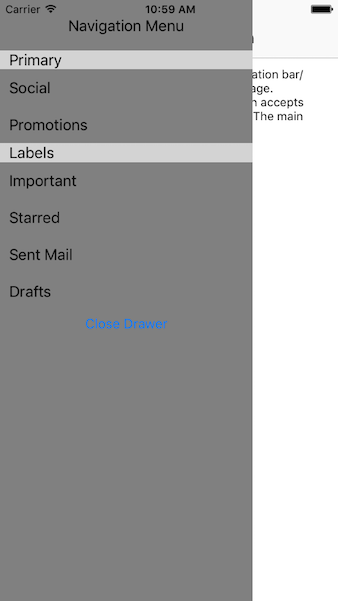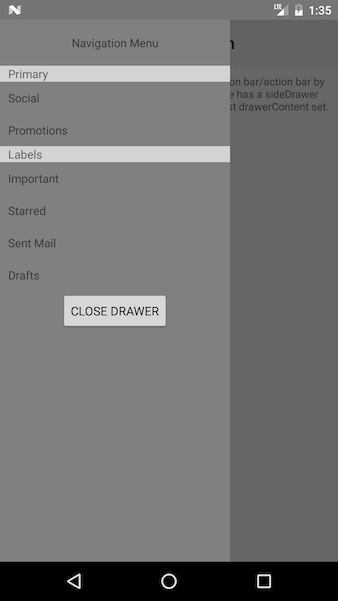With the 4.x.x release of the nativescript-ui-sidedrawer plugin the
RadSideDrawerno longer has a dedicatedshowOverNavigationproperty. More details can be found below in the "Migrating from versions 3.x.x to the latest version" section.
Share a single RadSideDrawer throughout the entire life cycle of the application
By popular desire we have revisited the way the
RadSideDrawer
is, was and wanted to be used by the community. While there are
a few cases where the current design API-wise was performing as
desired we heard overwhelmingly from the community that the
RadSideDrawer
is a fundamental element in most mobile applications and should
be easily shown everywhere inside of it. In the 3.x.x versions
in order to show the element on each Page you would
have to duplicate it in each XML declaration leading to less
than perfect experience and making maintenance quite redundant.
Having this in mind we revisited the API of the
RadSideDrawer
and implemented it in a way that the above "shared" use case is
possible while not changing its API too much to avoid major
breaking changes.
With the 4.x.x version of the plugin it is
possible to use the
RadSideDrawer
as the root element of your application. This
way it will be persisted and "shared" throughout the entire life
cycle of the application. In order to use the element as a root
simply:
-
Declare it where you used to declare your
Pageinstance in NativeScript 3.x.x -
Set the
drawerContentas usual -
Set the
mainContentto aFrameinstance and set itsdefaultPageto the first Page of your application
For example:
<nsDrawer:RadSideDrawer xmlns:nsDrawer="nativescript-ui-sidedrawer">
<nsDrawer:RadSideDrawer.drawerContent>
<GridLayout>
<Label text="Side Menu"></Label>
</GridLayout>
</nsDrawer:RadSideDrawer.drawerContent>
<nsDrawer:RadSideDrawer.mainContent>
<Frame defaultPage="./main-content-page"></Frame>
</nsDrawer:RadSideDrawer.mainContent>
</nsDrawer:RadSideDrawer>
By design when navigation is executed in the NativeScript
application that navigation will be executed inside the
Frame instance which means that the
RadSideDrawer
instance will be persisted during that navigation.
When using the
RadSideDrawer
as a root element it will by design
always be shown over the navigation bar.
Figure 1. RadSideDrawer as a root element and over navigation bar (ActionBar)


Migrating from Versions 3.x.x to the Latest Version
With the latest 4.x.x and above versions the
RadSideDrawer
element has had a few changes to its API and usage. There have
been two major changes:
-
The
showOverNavigationproperty has been removed and replaced by a change in the way the element is utilized. More details can be found below in the "Showing the RadSideDrawer over the navigation bar" section. -
The
RadSideDrawercan be "shared" throughout the entire life cycle of the application
Showing the RadSideDrawer over the Navigation Bar
With the latest versions in showing
RadSideDrawer
element above or below the navigation bar has been re-designed
and is no longer controlled by a property but rather by the way
the element is utilized in the application. While hearing a lot
of feedback from the community we noticed that the majority of
it was changing the showOverNavigation property
from its default value of false to
true and also was duplicating the element on each
Page. This is why we have introduced improvements
in both cases by allowing the element to be persisted throughout
the entire life cycle of the application which also by design
will shown over the navigation bar. It is no longer necessary to
set any property, simply set the
RadSideDrawer
as a root of your application. More details can be found above
in the "Share a single RadSideDrawer throughout the entire life
cycle of the application" section
How to Migrate from Duplicated RadSideDrawer to a Single Root Element
If you were using the
RadSideDrawer
element in 3.x.x you may have ended with duplicating its
declaration in each Page you have in your app. With
4.x.x this is no longer needed but it is backward compatible and
should work as expected. You can now truly "share" one
declaration in the entire application which is also the
recommended approach performance wise. Simply follow this common
steps for migrating from 3.x.x to 4.x.x:
-
Remove the duplicated
RadSideDrawerdeclarations from your XML -
In the XML of the bootstrapped
Page, replace that tag declaration with:
<nsDrawer:RadSideDrawer xmlns:nsDrawer="nativescript-ui-sidedrawer">
...
</nsDrawer:RadSideDrawer>
-
Set the
mainContentto aFrameinstance and set itsdefaultPageto the first Page of your application:
<nsDrawer:RadSideDrawer.mainContent>
<Frame defaultPage="main-content-page"></Frame>
</nsDrawer:RadSideDrawer.mainContent>
-
Change the bootstrapping of the application to the new
runsyntax:
import * as app from "application";
app.run({ moduleName: "main-page" });
If you find yourself in the need to access the
RadSideDrawer
from one of your Pages you can use the new
application module's
getRootView() function:
import { Application } from "@nativescript/core";
import { RadSideDrawer } from "nativescript-ui-sidedrawer";
let sideDrawer = <RadSideDrawer>Application.getRootView();